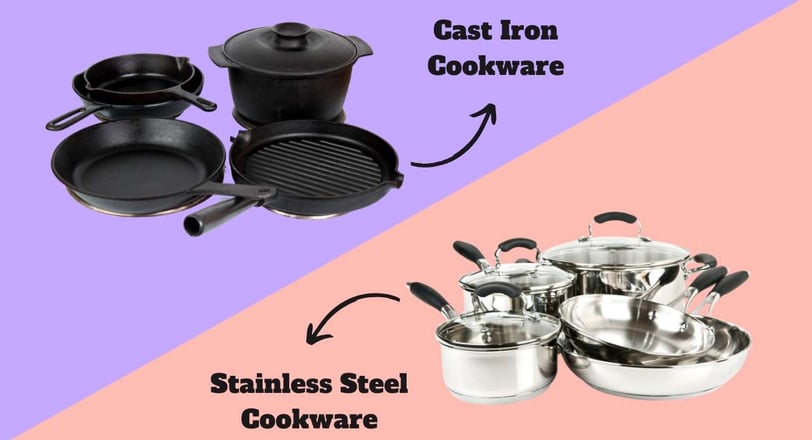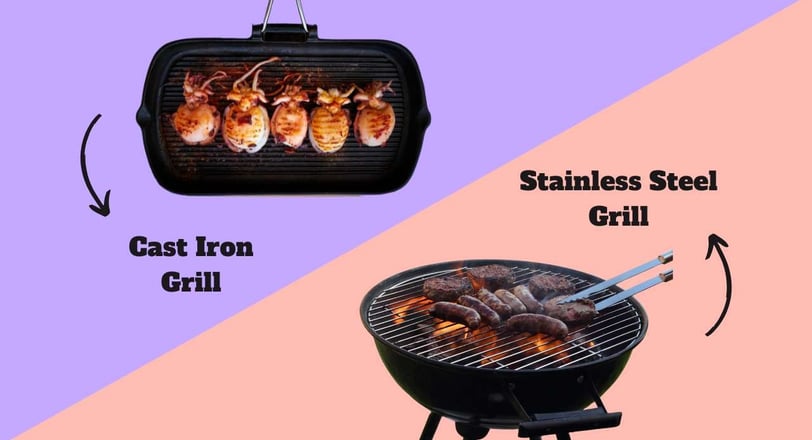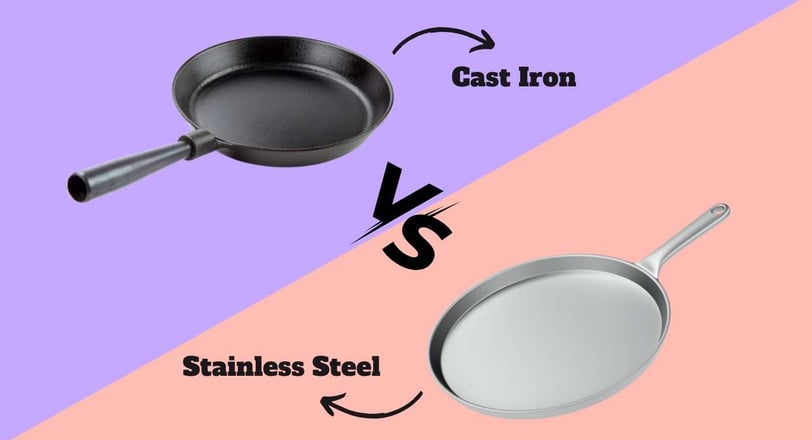Cast Iron vs Stainless Steel
Stainless Steel
Let's look at the reasons behind the widley used of stainless steel in daily cookery. The main reason? It heats up really fast, especially when cladded. Because of this, it's great for preparing meals quickly without requiring a long preheating times some cookware requires. Plus, here’s the kicker: you can use it with all kinds of food, including acidic dishes like tomato-based sauces, which aren’t ideal in cast iron.
Another great feature? Stainless steel pans are oven-safe—as long as the handles are made of oven-friendly materials. Keep in mind, though, that plastic or wooden handles won’t cut it for oven use. Most stainless steel cookware can handle temperatures up to 500°F (260°C), but it’s always smart to double-check your specific cookware’s temperature rating before putting it in the oven.
The problem with stainless steel is that, despite its durability and versatility, it isn't always the best choice. Eggs and other sticky items can be challenging to cook unless you have perfected the technique of properly heating and oiling the pan. A cast iron or non-stick pan could help you save time on cleanup for such tasks.
Cast Iron
Cast iron is the kitchen's slow cooker. It's perfect for recipes that need to be cooked at a steady, uniform temperature for a longer period of time, such as roasting, baking, or even recipes that go directly from the stovetop to the oven. The magic lies in its heat retention. Once it’s hot, it stays hot, which means your food cooks evenly without annoying temperature fluctuations.
If you love a good seared steak, cast iron is where it’s at. Thanks to its dense structure, it holds onto heat exceptionally well. Picture this: you drop a cold steak into a sizzling cast iron pan, and the pan doesn’t lose its heat. Instead, it keeps searing that steak to perfection. That’s something stainless steel just can’t match in the same way.
Cast Iron vs. Stainless Steel Cookware


How do you decide between the two, then? It truly depends on how you cook. For dishes that need for uniform, even heat, such as stews, cornbread, or a nicely seared steak, cast iron is the best option. It works well for high-heat cooking and frying as well.
In contrast, stainless steel is lightweight, multipurpose, and perfect for daily cooking. For sauces, acidic foods, or fast dinners, it's your best bet. In addition, it is much simpler to clean and maintain than cast iron, which requires particular care and seasoning.
How They’re Made
〰 Stainless Steel: This material combines iron, chromium, and nickel to create a durable, non-reactive surface that resists rust and stains. To improve heat conductivity, many stainless steel pans have a core layer of conductive metals like copper or aluminum.
〰 Cast Iron: Strong and long-lasting, cast iron is made by melting high-carbon iron and pouring it into molds. For increased protection and usability, the pans are polished and sometimes coated with an enamel finish after molding.
Cast Iron vs. Stainless Steel Pans
If you’re torn between a cast iron or stainless steel pan, think about what you cook most often. For searing steaks, frying, or baking skillet dishes, cast iron is unbeatable. Just remember it needs seasoning and proper care to avoid rust.
Stainless steel pans are better for sautéing, simmering, or making quick meals. They’re easier to clean and don’t require the extra maintenance that cast iron does.
Cast Iron vs. Stainless Steel Grill Grates


Both materials have special advantages when it comes to grill grates:
〰 Cast iron grates are the best at retaining heat. They are fantastic for getting restaurant-quality grilled results and give you those picture-perfect sear marks. To avoid rust, they need to be seasoned and maintained on a regular basis.
〰 Stainless steel grates are the sensible option since they are easier to clean and have a high level of rust resistance. They are popular among frequent grillers because they are low maintenance, even though they don't maintain heat as well as cast iron.
Cast Iron vs. Stainless Steel BBQ Grates
Listen up, barbecue lovers! Meats can be cooked slowly on cast iron grates. For foods like ribs or brisket, their ability to retain heat provides uniform cooking. But stainless steel BBQ grates are the best choice if you want a lighter, easier-to-maintain solution. Their longevity and ease of cleaning make them the ideal choice, even though they may cool down more quickly.
Cast Iron vs. Stainless Steel Health
Health-wise, both materials are safe, but there are differences:
〰 Cast Iron: It can leach small amounts of iron into your food, which might be beneficial if you’re iron-deficient. However, it’s worth noting that too much iron isn’t ideal for everyone.
〰 Stainless Steel: This doesn’t leach anything unless it’s scratched or damaged, making it a safer option for those concerned about metal leaching.
When to Use Cast Iron vs. Stainless Steel
〰 Cast Iron: Best for high-heat tasks like searing, frying, or oven-to-stove recipes. Think steaks, fried chicken, or cornbread.
〰 Stainless Steel: Perfect for delicate cooking like simmering sauces, boiling pasta, or preparing acidic ingredients.
Cast Iron vs. Stainless Steel for Steak
If steak is your thing, cast iron is often the go-to. Its heat retention gives you that steakhouse-quality crust every time. Stainless steel can get the job done too, but it doesn’t hold heat quite as well, making it harder to achieve that deep sear.
Which Is Better?
There’s no definitive answer—it all depends on what you’re cooking. Stainless steel wins for versatility, ease of cleaning, and daily use. Cast iron shines for its superior heat retention and ability to elevate specific dishes. Honestly, having both in your kitchen gives you the best of both worlds.
FAQs
Is cast iron better than stainless steel?
It depends on what you’re cooking and your priorities in the kitchen. Cast iron is better for high-heat tasks like searing steaks, frying chicken, or baking cornbread due to its superior heat retention. It delivers that unbeatable crust and even cooking you need for certain recipes. On the other hand, stainless steel is the better choice for quick-cooking tasks, acidic foods, and easy cleanup. It’s lightweight, non-reactive, and versatile for everyday cooking. Ideally, having both in your kitchen gives you the flexibility to tackle any recipe.
Does cast iron rust?
Yes, cast iron can rust if it’s not cared for properly. This happens when the protective layer of seasoning wears off, exposing the metal to moisture. To prevent rust, dry your cast iron thoroughly after washing and apply a thin layer of oil to the surface before storing it. If rust does develop, don’t panic—it can usually be removed with a bit of scrubbing using a steel wool pad or scrubber, followed by re-seasoning. With proper care, cast iron can last for generations.
Does stainless steel rust?
Stainless steel is highly resistant to rust, thanks to its chromium content, but it’s not completely immune. Rust spots may appear due to harsh conditions, including standing water or continuous exposure to salty air. Always make sure your stainless steel cookware is completely dry after cleaning and store it in a dry place to prevent this. Rust can also be prevented by purchasing premium stainless steel with a greater chromium strength.




